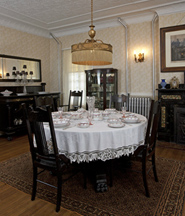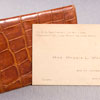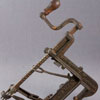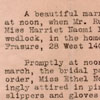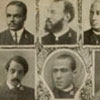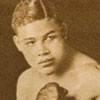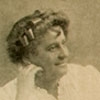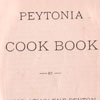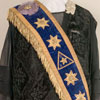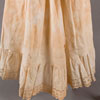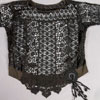
| A. Title: Dinner Discussions at Maggie Walker’s House |
||||||||||||||||||||||||||||||||||||||||||||||||||
|
||||||||||||||||||||||||||||||||||||||||||||||||||
| B. Overview of this Collection-Based Lesson Unit Plan |
||||||||||||||||||||||||||||||||||||||||||||||||||
|
||||||||||||||||||||||||||||||||||||||||||||||||||
| C. Museum Collections, Similar Items and other Materials Used in this
Lesson Unit Plan |
||||||||||||||||||||||||||||||||||||||||||||||||||
[Back to top] |
||||||||||||||||||||||||||||||||||||||||||||||||||
| D. National Educational Standards |
||||||||||||||||||||||||||||||||||||||||||||||||||
Social Studies ( National Council for the Social Studies, 1994.)
NSS-USH.5-12.8 ERA 8: THE GREAT DEPRESSION AND WORLD WAR II (1929-1945)
NSS-USH.5-12.9 ERA 9: POSTWAR UNITED STATES (1945 TO EARLY 1970s)
[Back to top] |
||||||||||||||||||||||||||||||||||||||||||||||||||
| E. Student Learning Objectives |
||||||||||||||||||||||||||||||||||||||||||||||||||
|
||||||||||||||||||||||||||||||||||||||||||||||||||
| F. Background and Historical Context |
||||||||||||||||||||||||||||||||||||||||||||||||||
Introduction Achievements In 1902, Mrs. Walker established a newspaper, The St. Luke Herald, to promote closer communication between the Order and the public. In speeches Mrs. Walker had reasoned, "Let us put our money together; let us use our money; … Let us put our money out at usury among ourselves, and reap the benefit ourselves." In 1903, she founded the St. Luke Penny Savings Bank. Mrs. Walker was the bank's first president and earned the recognition of being the first African American woman to charter a bank in the United States. Later she agreed to serve as chair of the board of directors when the bank merged with two other Richmond banks to become The Consolidated Bank and Trust Company. Until its purchase in 2005 by Adams National Bank, Consolidated was the oldest continually operated African American bank in the U.S. Today, Premier Bank operates from Consolidated’s former headquarters at First and Marshall Streets, where it continues to provide financial services to Mrs. Walker’s Jackson Ward community. In addition to her work for the Independent Order of St. Luke, Maggie Walker was active in civic groups. As an advocate of African American women's rights, she served on the board of trustees for several women's groups. Among them were the National Association of Colored Women (NACW) and the Virginia Industrial School for Girls. To assist race relations she helped to organize and served locally as vice president of the National Association for the Advancement of Colored People (NAACP) and was a member of the national NAACP board. She also served as a member of the Virginia Interracial Commission. Family Life Maggie Mitchell was educated in Richmond's public schools. After graduation, she taught grade school for three years. Her teaching career ended in 1886 when she married Armstead Walker Jr. She then directed her energies toward caring for her family and strengthening the Independent Order of St. Luke. Life was full and prosperous for the Walkers and their sons, Russell and Melvin. Tragedy struck in 1915 when her husband was accidentally killed, leaving Mrs. Walker to manage a large household. Her work and investments kept the family comfortably situated. When her sons married, they brought their wives to 110-1/2 East Leigh Street. A major addition to the house in 1922 enabled Mrs. Walker to provide a home for her sons and their families, her mother, and the household staff. Mrs. Walker's health gradually declined, and by 1928, she was using a wheelchair. Despite her physical limitations she remained actively committed to her life's work, including chairing the bank and leading the Independent Order of St. Luke, until her death on December 15, 1934. The House The furnishings throughout the home are original family pieces. They are valuable in understanding the 1904-1934 period of her occupancy. Together the house and the furnishings help us to learn more about Maggie Walker and the world in which she lived. Her community of Jackson Ward, a National Historic Landmark District, continues to exemplify the success of African American entrepreneurship. Source: http://www.nps.gov/mawa/historyculture/index.htm[Back to top] |
||||||||||||||||||||||||||||||||||||||||||||||||||
| G. Vocabulary |
||||||||||||||||||||||||||||||||||||||||||||||||||
Great Depression: –noun, economic crisis and period of low business activity in the U.S. and other countries, beginning with the stock-market crash in October, 1929 through the 1930s. |
||||||||||||||||||||||||||||||||||||||||||||||||||
| H. Teacher Tips |
||||||||||||||||||||||||||||||||||||||||||||||||||
|
||||||||||||||||||||||||||||||||||||||||||||||||||
| I. Lesson Implementation Procedures |
||||||||||||||||||||||||||||||||||||||||||||||||||
Lesson One: How to Read an ObjectDownload images of fruit peeler, calling card, and nuptials news release from Section C, Lesson 1. Make images available to students (computer lab, interactive whiteboard or TV /LCD projector screen.) Students analyze images and discuss.Distribute similar items to students. Working in pairs, students compare and contrast the historic objects with the contemporary ones and complete “How to Read a Museum Object.” Students share their responses with the class.Lesson Two: Living in the Time of Maggie L. WalkerDownload images of museum objects in the park collections, and obtain similar items and materials listed in Section C, Lesson Two.Maggie L. Walker knew many great African American figures, including W.E.B DuBois, Booker T. Washington, Mary McLeod Bethune, Joe Louis, Billie Holliday, Ella Fitzgerald, and others. Explain to the students that Maggie L. Walker kept many pictures, posters and photographs of her African American contemporaries on the wall of her library. Look at the 101 Prominent Colored People poster and have the students try to identify how many figures they recognize.Assign 2-3 students to a specific historic figure or have groups select an historic figure to research, including Maggie Walker. Students will use Library / Media center resources to research ONE of Maggie Walker’s business or social contemporaries. Students work cooperatively to answer questions below. The Maggie group answers questions in the first person.For what reason(s) is this person best remembered in U.S. history?
Lesson Two Extension: Students will work in designated groups to design a “Famous African Americans of Today” poster. Students may use magazines or download pictures from websites to obtain photos. Using scissors and glue, students will design and produce a patchwork of pictures on a poster board or large pieces of paper to create a modern-day “Famous African Americans” poster. Each group of students will take turns reenacting a portion of the dinner party. The student portraying Maggie L. Walker will act as host, posing 3-4 questions to each “guest.” Students respond in character to each question. Each group should be given 15-20 minutes to role play before assembling the next group. Role play continues until all groups have had an opportunity to “join Miss Maggie at the table.”At the conclusion of the dinner party, students write a news article about the dinner party for the Richmond or local newspaper’s society page or a reflective journal based on the role-playing experience. Pre- and post-writing strategies include students writing invitations to the party and a thank you note afterwards in “their” historic figure’s voice. |
||||||||||||||||||||||||||||||||||||||||||||||||||
| J. Evaluation/Assessment for Measurable Results |
||||||||||||||||||||||||||||||||||||||||||||||||||
|
||||||||||||||||||||||||||||||||||||||||||||||||||
| K. Extension and Enrichment Activities |
||||||||||||||||||||||||||||||||||||||||||||||||||
| Students research foodways and recipes of the period. Discuss with students how the invention of electricity and refrigeration changed the way Americans shopped, cooked and stored food in the early to mid-1900s vs. the new millennium, especially in the South. Each prepares an authentic dish similar to one found in a 1930s-40s Southern cookbook such as Mrs. Walker’s cookbook (See Section C, Lesson Two). Re-enact the dinner, with appropriate dinnerware/etiquette.
Prepare a dish and serve at school with the assistance of a home economics teacher or PTA /parent volunteer or do a potluck meal. See Section K for more resources on cooking during the Great Depression. Art: Have students design their own china and silver patterns or table linens. Language Arts: Students write a news article for the Richmond newspaper’s society page about the dinner party hosted by Mrs. Walker or a reflective journal based on the role playing experience. Students could also write invitations to the party, or a thank you note afterwards from the point of view of their character to practice letter writing skills. History: Students research family traditions through oral histories taken when interviewing relatives about the origin of certain holiday meals or family recipes. Math: Use the recipes from Maggie Walker’s cookbook to introduce or review the concept of converting fractions or to research and calculate the cost of ingredients for the meal in the 1930s vs. the new millennium. Math and science: Collaborate on a lesson involving the concept of “food miles,” how shopping for local produce and ingredients leaves less of a carbon footprint on the environment. Videotape the “Dinner Party” to share with other classes, or to use to critique each class and their performance. Students in accelerated classes could enrich this lesson by role-playing a second dinner party using modern political figures such as Barack Obama, Hilary Clinton, Jesse Jackson, Condoleeza Rice or George W. Bush. |
||||||||||||||||||||||||||||||||||||||||||||||||||
| L. Resources |
||||||||||||||||||||||||||||||||||||||||||||||||||
Websites
|
||||||||||||||||||||||||||||||||||||||||||||||||||
| M. Site Visit |
||||||||||||||||||||||||||||||||||||||||||||||||||
Visit the Maggie L. Walker home and historic Jackson Ward district in Richmond, VA. Take a virtual museum tour at: http://www.nps.gov/museum/exhibits/Maggie_Walker/index.html Unable to visit Maggie L. Walker National Historic site? Work with local historical societies or architects to identify neighborhoods close to your school which might provide example of homes and social life during the 1930s-40s. |
||||||||||||||||||||||||||||||||||||||||||||||||||
| N. Charts, Figures and other Teacher Materials Chart/Handouts | ||||||||||||||||||||||||||||||||||||||||||||||||||
Chart/Handouts
Media:
|
||||||||||||||||||||||||||||||||||||||||||||||||||
